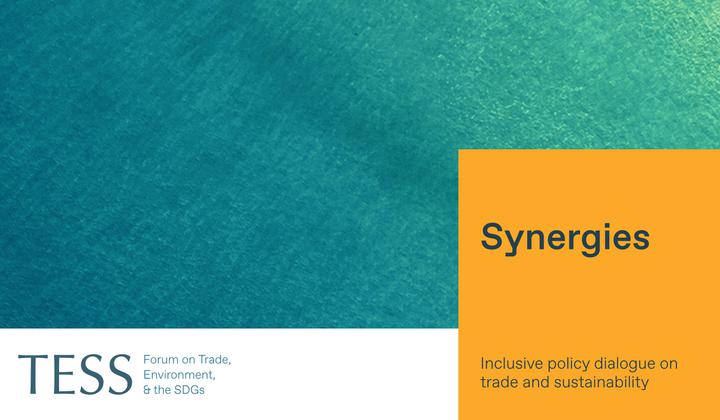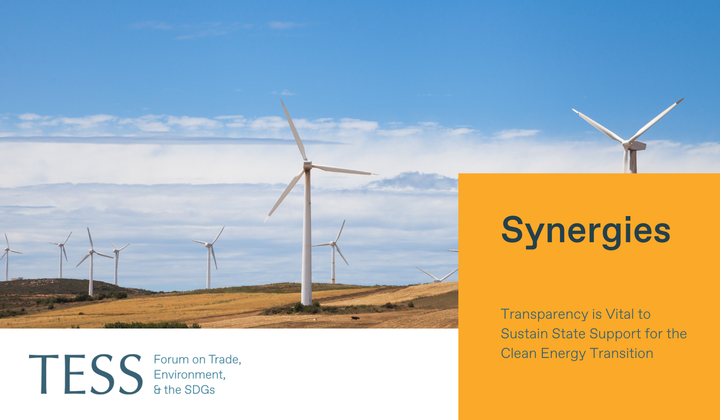With exponential demand for critical minerals vital for the green transition, governments have launched cooperative arrangements and initiatives to address potential critical minerals supply chain disruptions. Yet these arrangements are predominantly selective engagement, particularly between allies, and can be disruptive themselves. Addressing this global issue properly requires multilateral action.
This article is part of a Synergies series on reviving multilateralism curated by TESS titled From Vision to Action on Trade and Sustainability at the WTO. Any views and opinions expressed are those of the author(s) and do not necessarily reflect those of TESS or any of its partner organizations or funders.
-----
The Thirteenth Ministerial Conference (MC13) of the World Trade Organization (WTO) in Abu Dhabi largely left behind matters essential for safeguarding global supply chains for a green transition. Sitting at the very upstream of green supply chains are so-called critical minerals, such as lithium, nickel, and cobalt, which are vital for a range of green technologies. As green industrial policy proliferates worldwide, the demand for these minerals has increased exponentially. While some governments have launched cooperative arrangements to address potential critical minerals supply chain disruptions, these are predominantly selective engagement (particularly between allies) and can be disruptive themselves. Addressing this global issue properly requires multilateral action.
Critical Minerals and the Green Transition
Critical minerals are regarded as the oil of the twenty-first century. As reported by the International Energy Agency, to meet the Paris Agreement goals in the next two decades, the need for lithium, nickel and cobalt, and copper and rare earths—key minerals used for the production of electric vehicles and major renewables such as wind turbines and solar photovoltaics—will increase by 90%, 70%, and 40% respectively. The World Bank has also estimated that to meet the growing demand for clean energy technologies, the production of a wide spectrum of critical minerals will increase significantly by 2050, with the highest increase of nearly 500% for graphite, lithium, and cobalt.
The supply of critical minerals, however, is not guaranteed in most economies since the production and processing of these minerals are highly concentrated in a handful of countries. According to the same report of the International Energy Agency, Australia and Chile produce nearly 80% of the world’s lithium, Indonesia, the Philippines, and Russia nearly 60% of nickel, Peru and China around 50% of copper, the Democratic Republic of Congo around 70% of cobalt, and China itself around 60% of rare earths. While China does not control most of the mineral resources, it currently dominates the refining operations—an intermediate process necessary for purifying the minerals into usable components for manufacturing. At the same time, however, China is also a world’s top importer of many critical minerals, hence facing similar supply chain challenges as other economies.
The supply of critical minerals is not guaranteed in most economies since the production and processing of these minerals are highly concentrated in a handful of countries.
Critical Minerals Strategies and Initiatives
Faced with the growing demand and competition for critical minerals, major economies have developed a variety of strategies and policy instruments to strengthen their own supply chains. For example, as a typical resource-seeking economy, the European Union has rolled out a range of policies to foster extraction, processing, and recycling of critical minerals (i.e. inward-looking strategies) and to promote outbound investment in, and advance partnerships through, existing free trade agreements and new collaborative arrangements with resource-rich economies or allies (i.e. outward-looking strategies). The United States has also adopted a multidimensional strategy based on similar policy tools for similar goals, such as the well-known Inflation Reduction (IRA) which seeks to reshore and friendshore electric vehicle supply chains, including critical minerals used for their production, through massive subsidies.
In contrast, resource-rich economies’ critical minerals strategies have focused on capitalizing on the surging demand for such minerals by attracting foreign capital to help bolster their extraction and processing capabilities (e.g. Australia). They have also taken steps to protect their mineral resources and related industries through foreign investment screening (e.g. Canada), export restrictions, nationalization, and other defensive tools (e.g. Indonesia, Mexico, Chile).
Faced with the growing demand and competition for critical minerals, major economies have developed a variety of strategies and policy instruments to strengthen their own supply chains. Resource-rich economies’ strategies have focused on capitalizing on the surging demand for critical minerals by attracting foreign capital to help bolster their extraction and processing capabilities.
These strategies and policies, mostly unilateral, can stabilize one’s supply chains while disrupting those of others. Cooperative arrangements did emerge quickly to avoid this negative spillover but have remained bilateral or plurilateral initiatives among allies or like-minded countries. The United Kingdom, Japan, South Korea, and India, for example, have each entered a partnership with Australia. Japan also entered a critical minerals arrangement with the United States to become eligible for the subsidies under the IRA, which is also why the EU is contemplating a similar arrangement with the United States.
At the plurilateral level, the Supply Chain Agreement concluded under the Indo-Pacific Economic Framework for Prosperity (IPEF), the first of its kind and one of IPEF’s first landmark achievements, sets out shared goals and detailed actions to strengthen global supply chains. It indirectly addresses the critical minerals by referring to “key goods”, which are defined as “raw, in-process, or manufactured materials, articles, or commodities, the absence of which could have a significant effect on a Party’s national security, public health and safety, or prevention of significant or widespread economic disruptions.” While this agreement is a major step towards addressing supply chain challenges, its utility is limited as it excludes China.
Friendshoring critical minerals initiatives is, thus, motivated by security and geopolitical concerns which have led to a strategy of de-risking from China, as announced in the G7 Leaders’ Communiqué in May 2023. When it comes to critical sectors, however, decoupling seems to be the actual strategy being pursued. For economic, strategic, and security reasons it is understandable for governments to diversify supply chains, avoid over-dependency on any single source of supply, and compete in resource-abundant markets. China itself has pursued such diversification and global competition via its own critical minerals strategies.
Multilateralizing Critical Minerals Initiatives
The World Trade Organization provides an ideal forum for inclusive deliberation on what is truly a global issue.
China remains a key player in global supply chains and a top trading partner with many economies, including a majority of IPEF members. With China excluded, current critical minerals arrangements would provide only partial solutions to potential supply chain issues and may cause further uncertainties and disruptions. The ongoing geopolitical tensions are likely to remain a major obstacle for China to join these arrangements, especially IPEF. This is why the World Trade Organization provides an ideal forum for inclusive deliberation on what is truly a global issue.
The IPEF Supply Chain Agreement establishes mechanisms and concrete steps to monitor supply chain risks, enhance regulatory transparency, technical assistance, and capacity building, minimize market distortions and unnecessary trade restrictions, and promote labour standards. These efforts to tackle supply chain risks can be better achieved with China’s participation. Engaging China would also impose additional discipline or peer pressure, which would help enhance regulatory transparency and coordination by the Chinese government while disincentivizing it from non-market policies and practices or the weaponization of its dominant position in critical minerals supply chains. With the world’s two superpowers involved, multilateral negotiation would also create opportunities for them to play a leadership role in managing geopolitical conflicts while prioritizing cooperation in building resilient supply chains for the green transition.
For other countries, especially the many developing countries which now find themselves rich in resources that the world seek, a proper understanding of existing agreements is crucial for them to comprehend the issues at stake, available policy options, and potential ways to participate in these initiatives in a constructive manner. For this purpose, development agencies at the regional and global level need to incorporate critical minerals agreements in their technical assistance and capacity building plans and activities.
Hopefully, with such enhanced understanding, more governments will join in the efforts to multilateralize critical minerals initiatives and address unilateral and disruptive policies through coordinated action for certainty, stability, and sustainability.
-----
Henry Gao is Professor of Law, Singapore Management University.
Weihuan Zhou is Associate Professor, Director of Research, and Co-Director of the China International Business and Economic Law (CIBEL) Centre, Faculty of Law and Justice, University of New South Wales, Sydney.
Victor Crochet is a Senior Associate in the Brussels office of Van Bael & Bellis.
-----
Synergies by TESS is a blog dedicated to promoting inclusive policy dialogue at the intersection of trade, environment, and sustainable development, drawing on perspectives from a range of experts from around the globe. The editor is Fabrice Lehmann.
Disclaimer
Any views and opinions expressed on Synergies are those of the author(s) and do not necessarily reflect those of TESS or any of its partner organizations or funders.
License
All of the content on Synergies is licensed under a Creative Commons Attribution-NonCommercial-ShareAlike 4.0 International (CC BY-NC-SA 4.0)
license. This means you are welcome to adapt, copy, and share it on your platforms with attribution to the source and author(s), but not for commercial purposes. You must also share it under the same CC BY-NC-SA 4.0 license.
If you would like to reuse any material published here or if you have any other question related to Synergies, send an email to fabrice.lehmann@graduateinstitute.ch.



